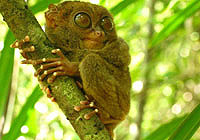
Bohol Tarsiers (Tarsius Syrichta) -measures 4 to 5 inches and is considered as the world’s smallest primate. Its size is no longer than an adult man’s hand and weigh only about 113 to 142 grams or four to five ounces. The primate belongs to the more primitive sub-order Prosimii or prosimian that dates back 45 million years.
With its tail longer than its body, it has large brown eyes, hairless ears and long finger-like claws. It has gray fur and a nearly naked tail that is more often than not about 232 mm in length. The tails arc over their back when they hop on the ground apparently to balance themselves. The underside of the tail has dermal ridges such as those found on human hands and feet.
Tarsiers have large mesmerizing eyes whose bony eye sockets are larger than that of its brain case as well as of its stomach. The eye sockets have post-orbital closure which keeps the eyeballs from being pressed against by the powerful temporal muscles to their sides.
Much like the owl, the tarsier can rotate its head 180 degrees in each direction. It has a joint between its skull base and spine to allow this particular head movement. Its upper lip lacks a cleft yet, but still has muscles, so that it can make facial expressions. The adult brain weighs about 4 grams.
Tarsiers have sharp teeth, enabling them to catch their prey easier. Unique among primates, tarsiers have only two, rather than four, incisors in their lower jaw. Their dental formula is 2.1.3.3 1.1.3.3 x 2 = 34.
The animal can also leap even up to 10 feet and agilely maneuver itself from tree to tree. This ability may be due to the fact that they have extra-long tarsal bones which form their ankles and enable them to leap so high. The tarsiers name was derived from the word ‘tarsal’.
Tarsiers in the other areas of the Philippines differ slightly. Those found in Samar and Leyte are named “T. philippensis”; in Bohol, “T. fraterculus”; and in Mindanao, “T. carbonarius”. It is believed though that the specie in the Philippines is of one kind but developed into three races due to separation and habitat adaptation.
Relatives of the Philippine tarsiers are found in Borneo, Sumatra and Indonesia: the tarsius bancanus of Borneo; the tarsius spectrum and tarsius pumilus of Sumatra; and tarsius dianae of Sulawesi, Indonesia. The pygmy tarsier (tarsius pumilus) is much smaller than the Philippine tarsier.




